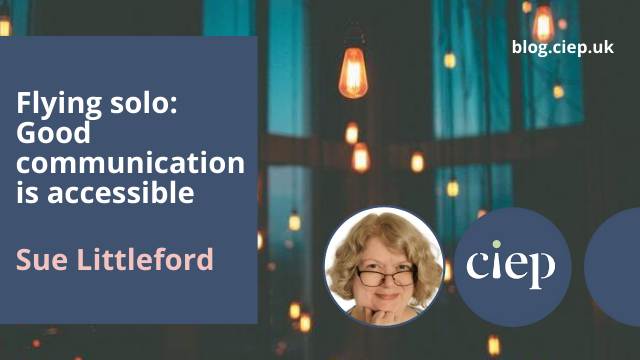This article by Sue Littleford, for our regular Flying Solo column in member newsletter The Edit, looks at a skill you need beyond editing in order to run a successful business: great customer service.

The article covers:
- What is customer service?
- Using the resources of the CIEP
- Why does customer service go wrong?
- Why you should demystify things for your client
- Learning to communicate effectively
- Getting the most out of contracts
For all we talk a lot about your editorial business being a business, it is a people-centric business. It’s not just indie authors – organisations are made up of people. You need people skills as well as word skills (and all the other skills).
Customer service isn’t just about doing a good job. It’s about how you do that job. You can be technically very good (nobody’s perfect, of which more anon) but you won’t get repeat clients if you’re a nightmare to deal with, or even just a bit prickly or offhand. On the other hand, you can be absolutely lovely, saying yes to everything, but fail to deliver on quality or timeliness.
Customer service comes up frequently for discussion. In 2019, Cathy Tingle, then I, then Vanessa Plaister all had something to say on the Institute’s blog. And shortly after I started the first draft of this piece, Cloud Club West started discussing the ethical side of dealing with clients (both clients’ ethics and ours), using the CIEP Code of Practice and Dignity Policy as a springboard. The same day, Hazel Bird published a great blog on being trustworthy. There was something in the air!
What is customer service?
We’ve all been customers ourselves, so it’s no mystery. I want to get what I meant to ask for, on time or a little earlier (so I’m not fretting down to the wire), at what I think of as a fair price. I want to be kept in touch with the process, but not feel I’m doing the job myself. I want to be alerted early of any difficulties. I want your technical competence.
Most of all, I want to feel secure in a safe pair of hands. And I want kindness – especially in a service like ours, where editorial comments and queries can be an endless stream of barbs puncturing the client’s feeling of pride in their work, and even their self-worth.
But if you’ve not been in a customer-facing role before, or not for a while, it can be easy to think about the job only from your own point of view: your own convenience, your own way of working, your own priorities, your own standards.
Remember: customer service is a two-way street, a conversation, an agreement between two parties, and those parties are people.
Using the resources of the CIEP
As ever, the Institute has already covered this ground in the Code of Practice and the model terms and conditions (T&Cs). Note that, at the time of writing, the T&Cs are being revised, but we’re talking principles here, not hard-and-fast wording.
If you’ve not been in a customer-facing role before, the Code of Practice section 3 and section 5 cover what’s required for freelancing copyeditors and proofreaders. If you offer project management, then you also need to read section 6. If you’re in-house, then you want section 4.
The Dignity Policy focuses on how members treat members, but there’s a reminder in the ‘Statement of expectations’ that there’s an overlap with section 3.1 and section 3.3 of the Code of Practice regarding what may be construed as unprofessional conduct.
Why does customer service go wrong?
My opinion is that it’s usually down to a mismatch of expectations. No, a proofread isn’t a development edit. No, a proof-edit isn’t a great way to save money getting your first draft published. No, I can’t rewrite your 10,000-word dissertation over the weekend for you, and I wouldn’t even if I could. No, my schedule isn’t all about you.
No, your first-time author doesn’t understand publishing inside out. No, your novice client doesn’t have a crystal ball to know all the assumptions you’ve made about their experience. No, your client probably has no idea that sending in a novel chapter by chapter is less than helpful, and demanding it back chapter by chapter so they can carry on changing stuff is even less so. Please no Google Docs! Please! You can’t edit or proofread while your impatient author watches you fillet their book, and keeps adding little tweaks while you’re doing that … And remember, your client may not be your ultimate client, especially if you’re working with business materials.
Many clients have no idea what it is they don’t know. You’re in a position of power, here, and you mustn’t misuse or abuse it.
Educating your client well (and nicely) is an opportunity for great customer service.
Why you should demystify things for your client
In my long-ago salaried days, when I moved from central government to the private sector (a move that very much felt like gamekeeper to poacher) one of the buzzwords my new employer used a lot was the need to make my erstwhile department an ‘intelligent customer’.
What that apparently rather insulting phrase actually means is educating your client to understand what’s sensible to ask for, what’s going to be ruinously expensive, how much time things are likely to take and that scope creep is a Bad Thing. I heard it most whenever contracts were being negotiated for new services, the kind of contracts that run into eight figures.
Starting to sound like a useful concept, once the prices are scaled down? Editors dealing with novice clients have to, or ought to, spend a fair bit of time educating those authors about the publishing process insofar as it applies to them.
The bottom line is that it’s worth the effort of ensuring both you and your client understand each other’s needs, wishes and expectations – unless you like tearing your hair out, giving refunds and worrying your reputation is going to be trashed online, of course.

Communicate, communicate, communicate
A year ago, Caroline Petherick was kind enough to share an information sheet that she sends to prospective clients, on the CIEP Forums (thanks to Christina Petrides for reminding me of this, and for finding the link).
Explore what the client wants. Find out what they actually mean by the words they use. We’ve all had a client ask for a ‘proofread’ when they mean a developmental edit and a copyedit or two first. Why should they already know the intricacies of our world?
Explain what you can and can’t do. If the client is a student, you also need to ensure the supervisor has approved outside help, and get hold of the institution’s guidance on what you’re allowed to do and, importantly, what you mustn’t do.
Ask questions – I often ask which draft number the client is on (too low a number and I know it’s not ready for a copyedit quite yet) – and if the client is surprised that the first draft isn’t the one that’s published, you know where you are in terms of what you need to teach the client, if you’re interested in taking on the job.
On the other hand, don’t bury your client under a tidal wave of interrogation that seems very one-way. It’s a conversation, remember.
Perfection, the impossible dream
Do not, under any circumstance, say you’ll make the text ‘perfect’. There is no such thing. Honestly, there isn’t. Language being what it is, how we express ourselves is an art rather than a science. Comma placement, for starters. Your perfect is my ‘I don’t like that’. My perfect is your ‘who on earth does it that way?’ Spelling, hyphenation, what’s italicised … whatever you’d put in a style sheet is a place for your client to say ‘I don’t like that’ or even ‘You’re wrong. When I was seven, Miss told me you do it this way.’
Promising the impossible is not good customer service, and it gives your client an enormous stick to beat you with, because the two of you will have different ideas of what perfection looks like.
Keep it real
Manage your client’s expectations. The standard advice is under-promise and over-deliver. I’d agree with that, but caution you not to take liberties in either direction.
Over-promising is a pretty daft thing to be doing. It may win you the job, but that’s about all – and the downside may just keep on giving. Don’t promise a standard you can’t deliver, a speed you can’t meet or a competence you don’t yet have.
But don’t go so far the other way that your performance overrides the service the client thought they’d agreed to. They may not believe your assertion that you really need four weeks the next time, and insist your deadline is in ten days, ‘because you did it before’. Wild over-delivering is also a pretty daft thing to be doing.
Use your contract for the heavy lifting
Your contract is another good place to start on the route to an intelligent customer, this time on the business aspects of your relationship. I’m happy to recommend Karin Cather and Dick Margulis’s book The Paper It’s Written On as, although the authors are American, the principles apply across jurisdictions. The book takes you through the type of content you may want to include as it sets out the basis of your working relationship with your client. What will you do? When will you do it? What are the client’s obligations to supply original material, on time, in no worse condition than the sample and of the length you quoted for?
What happens if something goes wrong, whether that’s illness, pandemic or some other crisis? Can you or will you be subcontracting the work? What if the client is unhappy with what you’ve done, or wants to cancel before you’ve started? What are the remedies? Anticipate, anticipate, anticipate!
When is it over?
One thing you need to be very clear about is when the job is finished. How many times, or how much later, can a client come back and say they found a missing apostrophe on p 327 and expect you to refund half your fee? When does the hand-holding stop?
This is where all your communication comes into play. From the outset, you must circumscribe the job. It must go in your contract and in your initial emails.
This is also a good defence against scope creep – just a new paragraph, just a new chapter, just this, just that. Remember the old adage: don’t set yourself on fire to keep somebody else warm.
So, what did Cloud Club West talk about?
A lot! (We always do, and I promised them namechecks.)
Key advice included:
Katherine Kirk reminded us that email etiquette is in the CIEP’s Code of Practice, and sent us to check out Malini Devadas’s podcast on maintaining boundaries.
Alice Yew has a boundary around working on shared documents, whether that’s Overleaf, Google Docs or what have you, but explains to potential clients the adverse impact of an author updating a file that’s being edited or proofread, so that they understand the reason.
Many people reported clients insisting on phone calls (which miraculously take up none of your time and are therefore free, as you aren’t actually editing or proofreading, are you? Katie Ellis reminded us of this recent forum thread on that point), or communicating via WhatsApp at unsocial times (or at all!).
Lisa Davis doesn’t publish her phone number anywhere; Janet MacMillan and several others have language in their contracts that stipulates communication must be by email only, so that both parties have a written record of what’s been said, asked for and agreed.
Laurie Duboucheix-Saunders and I told of technically challenged clients, unable to handle emails or Word documents. If you take on a client like this, your standard contract and up-front emails will need to reflect the different requirements, but be alert to the many ways that people can work around their difficulties with technology (including someone who printed out a PDF, hand-annotated it and sent back photographs of the pages) and make sure that you can either help your client to learn a better way of doing things, or that your contract enables you to increase your time and/or your fee if your client won’t or can’t follow the stipulated communication methods, although Christina Petrides reminded us to be flexible when we can.
Alex Peace’s contract sets out precisely how and in what format files will be exchanged. As she’s mostly an indexer, that’s critical to her.
Laurie Duboucheix-Saunders moved us on to the duty to respond to queries, even if you don’t want to take the job on, and Ayesha Chari advised telling students why you don’t want to take on a job, if their expectations are wide of the mark, and it’s not clear they have supervisor approval.
Sam Kelly reminded us of the importance of educating clients if they’re not yet comfortable with features like Track Changes. One of his rejected all the changes, thinking he’d accepted them, and the journal rejected the article as being in dire need of editorial attention. Cue much angst all round.
Helena Nowak-Smith knows what it’s like to have clients who don’t understand that you may have other projects on the go and that getting their text to you late will impact the delivery date; whereas Marieke Krijnen has encountered more plagiarism than she ever thought possible. Lots of advice followed from Cloud Club West members to include anti-plagiarism language on your website and in your contract as part of your intelligent customer efforts.
Conclusion
If you want your clients to be loyal and to keep coming back with more work, maintaining good customer service is part and parcel of the job. Some clients may forgive the occasional off day. Others won’t. Most won’t forgive multiple off days. Investing time in your clients and building those relationships, within healthy boundaries, is an investment in your business.
When my long-established freelancing brother heard I was throwing in the salaried towel and setting up for myself, too, this is what he drummed into me.
You. Are. Only. As. Good. As. Your. Last. Job.
I agree with him, but would add:
And. The. Way. You. Did. It.
Summing up
- Customer service is essential.
- Investing in relationship building is an investment in your business.
- The standard of work you produce matters, but so does how you do it.
About Sue Littleford
 Sue Littleford is the author of the CIEP guide Going Solo, now in its second edition. She went solo with her own freelance copyediting business, Apt Words, in March 2007 and specialises in scholarly humanities and social sciences. Before that, she had been the payroll manager for a major government department for some 14 years.
Sue Littleford is the author of the CIEP guide Going Solo, now in its second edition. She went solo with her own freelance copyediting business, Apt Words, in March 2007 and specialises in scholarly humanities and social sciences. Before that, she had been the payroll manager for a major government department for some 14 years.
Her whole career had been markedly numbers based – both in central government and in the private sector – even though she became the go-to wordsmith everywhere she worked. She eventually switched to words full-time, transferring her skills and experience to hone her business efficiency and effectiveness.
 About the CIEP
About the CIEP
The Chartered Institute of Editing and Proofreading (CIEP) is a non-profit body promoting excellence in English language editing. We set and demonstrate editorial standards, and we are a community, training hub and support network for editorial professionals – the people who work to make text accurate, clear and fit for purpose.
Find out more about:
Photo credits: header image by ChristianChan on Canva, We hear you by Jon Tyson on Unsplash.
Posted by Abi Saffrey, CIEP blog coordinator.
The views expressed here do not necessarily reflect those of the CIEP.
 Accessibility shouldn’t be an afterthought. You shouldn’t make a thing and then think, ooh, I guess I should make it accessible. Instead, build accessibility into the thing from the start.
Accessibility shouldn’t be an afterthought. You shouldn’t make a thing and then think, ooh, I guess I should make it accessible. Instead, build accessibility into the thing from the start. Good accessible communication is honest
Good accessible communication is honest Sue Littleford is the author of the CIEP guide Going Solo, now in its second edition. She went solo with her own freelance copyediting business, Apt Words, in March 2007 and specialises in scholarly humanities and social sciences.
Sue Littleford is the author of the CIEP guide Going Solo, now in its second edition. She went solo with her own freelance copyediting business, Apt Words, in March 2007 and specialises in scholarly humanities and social sciences. About the CIEP
About the CIEP

